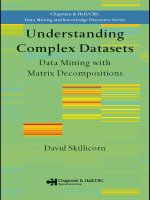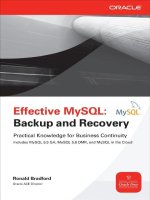IT training thenewstack book3 automation and orchestration with docker and containers khotailieu
Bạn đang xem bản rút gọn của tài liệu. Xem và tải ngay bản đầy đủ của tài liệu tại đây (2.31 MB, 141 trang )
3
vol.
AUTOMATION
& ORCHESTRATION
WITH
DOCKER
& CONTAINERS
EDITED & CURATED BY ALEX WILLIAMS
The New Stack:
The Docker and Container Ecosystem eBook Series
Alex Williams, Founder & Editor-in-Chief
Benjamin Ball, Technical Editor & Producer
Hoang Dinh, Creative Director
Sam Charrington, Editor, Founder and Principal Analyst of CloudPulse
Strategies
Contributors:
Joab Jackson, Managing Editor
Judy Williams, Copy Editor
Lawrence Hecht, Data Research Director
Michelle Maher, Copy Editor
TABLE OF CONTENTS
Introduction .................................................................................................................................. 4
Sponsors ........................................................................................................................................ 6
AUTOMATION & ORCHESTRATION WITH DOCKER & CONTAINERS
Key Concepts in Orchestration .................................................................................................. 7
Bridging Realities: Orchestration and Programmable Infrastructure ..............................17
IBM: Shaping Container Usage: Education, Open Source & Standards ..........................29
Peer Perspectives on Container Orchestration Survey.......................................................30
Cisco: Cloud-Native Capabilities and a Deeper User Experience .....................................54
Consideration for Containers in Production .........................................................................55
Apcera: Creating a Fine-Grained User Experience for Container Management .............69
Bakery as a Foundation: Container Images and Microservices ........................................70
Gaining Visibility Into Managing Containerized Applications........................80
...................................................................81
Container Orchestration and Scheduling: Herding Computational Cattle ....................92
Mesosphere: Unifying and Orchestrating Opinionated Frameworks and Services ....100
The Emerging Containers as a Service Marketplace .........................................................101
Docker: Building Open Source Tools for the Democratic Internet .................................110
AUTOMATION & ORCHESTRATION DIRECTORY
Build/Deploy (including Continuous Integration/Delivery).............................................112
Orchestration: Cluster Management ....................................................................................123
........................................................................125
Orchestration: Scheduling......................................................................................................127
Orchestration: Service Discovery ..........................................................................................131
Orchestration: Other Orchestration-Related Tools ...........................................................133
Platforms/PaaS (including CaaS)..........................................................................................135
Disclosures.................................................................................................................................140
AUTOMATION & ORCHESTRATION WITH DOCKER & CONTAINERS
3
INTRODUCTION
The container ecosystem has become a very crowded space. Increasing
rates of container adoption and usage in production means that the
management and orchestration space is just that much more important.
In this ebook, The New Stack explores the ways that vendors and
practitioners are automating, orchestrating, and managing their container
technologies in multiple environments. We take a closer look at
comparisons of major orchestration tools, including orchestration
platforms and containers as a service, and how orchestrating containers is
a critical component for advancing a wider usage pattern for containers.
We cover the basic components that go into orchestrating containers, and
management, and even beyond into the role of infrastructure and
platforms. We discuss how this space compares to virtual machine
management, and how many of the same concepts apply within the
Another major focus of the ebook is on original research surrounding the
perceptions of end users and vendors. We created an orchestration survey
that looked primarily to measure the expectations of our audience about
the functionality of orchestration tools; we also asked respondents to
report their current and projected usage of tools, level of container
adoption, usage of container technologies in production environments,
and more. The resulting data paints a very interesting picture of the
current market for orchestration tools and services, and we look to build
upon and analyze this data even more in the coming months.
AUTOMATION & ORCHESTRATION WITH DOCKER & CONTAINERS
4
INTRODUCTION
This is our third ebook in the Docker and Container Ecosystem series, and
going to address more around networking, storage and security, it was
important to establish the goals of orchestration and management in this
book. The primary concepts around container management are prevalent
throughout the rest of the book series, and this ebook provides a
necessary foundation for understanding the choices users will need to
make about their technology and practices.
This book represented an enormous challenge for us in some ways, as the
orchestration space is perhaps the most contested in the container
involves so many types of behaviors and practices, that it’s no wonder
vendors are so eager to capture the attention of Dev and Ops alike.
As I’ve said before, we’re constantly looking for new topics in need of
greater focus and education, and we welcome any feedback on what
areas we should tackle next, even beyond the container ecosystem.
Thanks so much for your interest in our ebook series. Please reach out to
our team any time with feedback, thoughts, and ideas for the future.
Thanks,
Ben
Benjamin Ball
Technical Editor and Producer
AUTOMATION & ORCHESTRATION WITH DOCKER & CONTAINERS
5
SPONSORS
We are grateful for the support of the following ebook series sponsors:
And the following sponsors for this ebook:
AUTOMATION & ORCHESTRATION WITH DOCKER & CONTAINERS
6
KEY CONCEPTS
IN ORCHESTRATION
by JANAKIRAM MSV
he Docker platform and surrounding ecosystem contain many
tools to manage the lifecycle of a container. Just one example,
Docker Command Line Interface (CLI) supports the following
container activities:
T
• Pulling a repository from the registry.
• Running the container and optionally attaching a terminal to it.
• Committing the container to a new image.
• Uploading the image to the registry.
• Terminating a running container.
While the CLI meets the needs of managing one container on one host, it
falls short when it comes to managing multiple containers deployed on
multiple hosts. To go beyond the management of individual containers,
we must turn to orchestration tools.
AUTOMATION & ORCHESTRATION WITH DOCKER & CONTAINERS
7
KEY CONCEPTS IN ORCHESTRATION
“
Orchestration tools extend
lifecycle management capabilities
to complex, multi-container
workloads deployed on a cluster
of machines.
By abstracting the host infrastructure, orchestration tools allow users to
treat the entire cluster as a single deployment target.
Baseline Features
The process of orchestration typically involves tooling that can automate
all aspects of application management from initial placement, scheduling
and deployment to steady-state activities such as update, deployment,
update and and health monitoring functions that support scaling and
failover. These capabilities have come to characterize some of the core
Orchestration tools provide an option for DevOps teams to declare the
blueprint for an application workload and its configuration in a
standard schema, using languages such as YAML or JSON. These
definitions also carry crucial information about the repositories,
networking (ports), storage (volumes) and logs that support the
workload. This approach allows orchestration tools to apply the same
configuration multiple times and always yield the same result on the
target system. It also allows the tools to accept different
AUTOMATION & ORCHESTRATION WITH DOCKER & CONTAINERS
8
KEY CONCEPTS IN ORCHESTRATION
configurations for the same application during the various stages of
development, testing and production for different target
environments.
Rules and Constraints
performance and high availability. For example, it’s pointless to provision
the master and slave database container on the same host; it defeats the
purpose. Similarly, it may be a good idea to place in-memory cache on the
same host as the web server. Orchestration tools support mechanisms for
Provisioning, or scheduling, deals with negotiating the placement of
containers within the cluster and launching them. This process involves
container-provisioning API, orchestration tools will invoke the
Discovery
In a distributed deployment consisting of containers running on multiple
hosts, container discovery becomes critical. Web servers need to
dynamically discover the database servers, and load balancers need to
discover and register web servers. Orchestration tools provide, or expect,
a distributed key-value store, a lightweight DNS or some other mechanism
to enable the discovery of containers.
AUTOMATION & ORCHESTRATION WITH DOCKER & CONTAINERS
9
KEY CONCEPTS IN ORCHESTRATION
system’s containers and hosts. In the event of host failure, the tools can
relocate the container. Similarly, when a container crashes,
orchestration tools can launch a replacement. Orchestration tools
ensure that the deployment always matches the desired state declared
by the developer or operator.
A Closer Look at Three Popular
Orchestration Platforms
Docker Swarm
The objective of Docker Swarm is to use the same Docker API that works
with the core Docker Engine. Instead of targeting an API endpoint
FIG 1: Docker Swarm features pluggable scheduling algorithms and broad registry
support. Communication between manager and nodes uses standard Docker APIs.
Docker Swarm: Swap, Plug, and Play
Discovery
Backend
Manager
Scheduler
Discovery
Service
Following Docker’s “batteries included,
but removable” philosophy, several
discovery backends are supported,
esses,
etcd, Consul and ZooKeeper. Scheduler
strategies are pluggable as well.
Node 1
Node 2
Node “n”
Docker Daemon
Docker Daemon
Docker Daemon
Containers
Containers
Containers
AUTOMATION & ORCHESTRATION WITH DOCKER & CONTAINERS
Source: The New Stack.
10
KEY CONCEPTS IN ORCHESTRATION
representing one Docker Engine, Swarm transparently deals with an
endpoint associated with a pool of Docker Engines. The key advantage to
this approach is that the existing tools and APIs will continue to work with
a cluster in the same way they work with a single instance. Docker’s
tooling/CLI and Compose are how developers create their applications
and therefore they don’t have to be recoded to accommodate an
orchestrator.
Docker Swarm comes with several built-in scheduling strategies, giving
users the ability to guide container placement so as to maximize or
minimize the spread of containers across the cluster. Random placement
is supported as well.
Docker seeks to follow the principle of “batteries included but removable,”
meaning that while it currently ships with only a handful of simple
scheduling backends, in the future it may support additional backends
through a pluggable interface. Based on the scale and complexity of a
appropriate backend.
scheduling. They can be based on attributes like storage type, geographic
collocate containers on hosts.
For discovering containers on each host, Swarm uses a pluggable
backend architecture that works with a simple hosted discovery service,
AUTOMATION & ORCHESTRATION WITH DOCKER & CONTAINERS
11
Kubernetes: Building on Architectural Roots
KEY CONCEPTS IN ORCHESTRATION
etc daemon
Master
API Server
Replication
Controller
Scheduler
Minion 1
Minion 2
Minion “n”
Kubelet
Kubelet
Kubelet
Containers
Containers
Containers
Source: The New Stack.
FIG 2: Kubernetes traces its architectural lineage to Google Borg, an internal cluster
management system responsible for launching over 2 billion containers per day.
Swarm supports basic health monitoring, which prevents provisioning
containers on faulty hosts.
Kubernetes
Coming from Google — a company that claims to deal with two billion
containers every day — Kubernetes
Kubernetes’ architecture is based on a master server with multiple
minions. The command line tool, called kubecfg, connects to the API
endpoint of the master to manage and orchestrate the minions. Below is
environment:
AUTOMATION & ORCHESTRATION WITH DOCKER & CONTAINERS
12
KEY CONCEPTS IN ORCHESTRATION
• Master: The server that runs the Kubernetes management processes,
including the API service, replication controller and scheduler.
• Minion: The host that runs the kubelet service and the Docker Engine.
Minions receive commands from the master.
• Kubelet: The node-level manager in Kubernetes; it runs on a minion.
• Pod: The collection of containers deployed on the same minion.
• Replication controller:
that need to be running.
• Service:
published by each container, along with the external proxy used for
communications.
•
The command line interface that talks to the master to
manage a Kubernetes deployment.
and DNS name that corresponds to a dynamic set of pods. When a
container running in a Kubernetes pod connects to this address, the
connection is forwarded by a local agent (called the kube-proxy) running
on the source machine to one of the corresponding backend containers.
Kubernetes supports user-implemented application health checks. These
checks are performed by the kubelet running on each minion to ensure
that the application is operating correctly. Currently, Kubernetes supports
three types of health checks:
• HTTP health check: The kubelet will call a web endpoint. If the
AUTOMATION & ORCHESTRATION WITH DOCKER & CONTAINERS
13
KEY CONCEPTS IN ORCHESTRATION
response code is between 200 and 399, it is considered a success.
• Container exec: The kubelet will execute a command within the
container. If it returns “OK,” it is considered a success.
• TCP socket: The kubelet will attempt to open a socket to the
container and establish a connection. If the connection is made, it is
considered healthy.
Apache Mesos
Apache Mesos
complexity of running tasks on a shared pool of servers. Originally
FIG 3: With roots in the high performance computing world, Mesos supports Hadoop,
Spark and more in addition to Docker and containers.
Apache Mesos: Built for High-Performance Workloads
ZooKeeper
Mesos Master
Standby Master
Standby Master
Master
Daemon
Master
Daemon
Master
Daemon
Slave 1
Slave 2
Slave “n”
Slave Daemon
Slave Daemon
Slave Daemon
Containers
Containers
Containers
AUTOMATION & ORCHESTRATION WITH DOCKER & CONTAINERS
Source: The New Stack.
14
KEY CONCEPTS IN ORCHESTRATION
designed to support high-performance computing workloads, Mesos
added support for Docker in the 0.20.0 release.
A typical Mesos cluster consists of one or more servers running the mesosmaster and a cluster of servers running the mesos-slave component. Each
with deployed frameworks to delegate tasks to slaves. Below is an
overview of Mesos’ architecture:
• Master daemon: The mesos-master service runs on a master node
and manages slave daemons.
• Slave daemon: The mesos-slave service runs on each slave node to
run tasks that belong to a framework.
• Framework:
more executors to launch tasks on the slaves.
•
The list of a slave node’s resources. Each slave node sends
application frameworks.
• Task: The unit of work scheduled by a framework to be executed on a
slave node.
• Apache ZooKeeper:
of master nodes.
Unlike other tools, Mesos ensures high availability of the master nodes
AUTOMATION & ORCHESTRATION WITH DOCKER & CONTAINERS
15
KEY CONCEPTS IN ORCHESTRATION
nodes in the system, including masters and slaves, communicate with
leader performs health checks on all the slaves and proactively
deactivates any that fail.
When Mesos is used in conjunction with Marathon, service discovery
can be enabled based on the HAProxy TCP/HTTP load balancer, along
with an assistant script that uses Marathon’s REST API to periodically
regenerate a HAProxy configuration file. Alternatively, Mesos-DNS, a
DNS-based service discovery mechanism, has recently been released
in beta.
Summary
The container ecosystem is growing rapidly. From major infrastructure
companies to PaaS vendors to early-stage startups and even in serverless
computing, everyone is clamoring to stake out their place in the
ecosystem. There are many contributors working on container
orchestration tools, as these are essential for deploying real-world
applications, thus driving the adoption of Docker and containers. We
attempted to highlight some of the key contributors building orchestration
tools, but there is more to it than just explicit orchestration tools — it’s
also important to look at the build, deployment, CI/CD, PaaS, and other
tools that orchestrators interact with, which we cover at great length in
the Automation and Orchestration Directory.
AUTOMATION & ORCHESTRATION WITH DOCKER & CONTAINERS
16
BRIDGING REALITIES:
ORCHESTRATION
AND PROGRAMMABLE
INFRASTRUCTURE
by ALEX WILLIAMS and BENJAMIN BALL
T
are contrary views surrounding VMs, containers and the roles they
play in automated, scaled-out environments. There are also many
unknowns, as most technical professionals have little experience developing on distributed platforms. Most people have developed on single
hosts or managed systems as administrators, managing machines and
their virtualized environments.
Running clusters and orchestrating thousands of containers is an entirely
an advanced appreciation of automation via APIs, and orchestration that
takes into account the need for scheduling, cluster management and a
host of other matters, such as securing nodes, health checks and
prioritization.
AUTOMATION & ORCHESTRATION WITH DOCKER & CONTAINERS
17
BRIDGING REALITIES: ORCHESTRATION AND PROGRAMMABLE...
“
Running clusters and orchestrating
thousands of containers is an entirely
new game.
Today we see how orchestration for containers changes the lens of how
we view applications. Microservices orient developers to focus on services
for making these applications behave according to the components on
distributed clusters. Apache Mesos, Docker Swarm, HashiCorp Nomad
and Kubernetes are good examples of this. They help systems operators
model their clusters and make services accessible.
ephemeral. For companies adopting elastic, scaled-out platforms, the
metal and create container-based clusters.
This all adds up to a change in how we think about automation and
orchestration. But one principle remains: there’s a push to implement
programmable infrastructure, applying methods and tooling established
across thousands of clouds. It’s a movement that will lead to any number
of new practices and discoveries.
behind programmable infrastructure, said Solomon Hykes, Docker
AUTOMATION & ORCHESTRATION WITH DOCKER & CONTAINERS
18
BRIDGING REALITIES: ORCHESTRATION AND PROGRAMMABLE...
developer without ten years or more of programming experience. Scale
needs to be at the scale of the Internet, Hykes said.
“So clustering, orchestration, networking between containers, storage
across more than one container, that shared storage, security, things like
provenance of the containers you’re about to deploy,” Hykes said. “All of
these are part of the problem of building and deploying distributed
applications. So it’s a big list of problems and you need a combination of
tools to address these problems. And you need those tools to integrate.
They need to work together to form a platform, otherwise you’ve got a
the puzzle.”
Hykes will tell you that Docker takes an incremental approach with tool
development and does not try to “boil the ocean” by developing one
platform to do it all. It’s an approach that applies to the overall Docker
and container ecosystem. That is, in part, due to the complexity that scale
brings and the very nature of container technology itself.
Docker and containers are processes. They make delivering
components easier. A container does not carry an operating system
with it. That makes the container lighter and easier to manage. It does
disposable — it embodies the concept of immutable infrastructure; live
instances are never directly changed, but rather replaced as their
containers, in their current packaged form, introduce new complexities
previously not understood.
AUTOMATION & ORCHESTRATION WITH DOCKER & CONTAINERS
19
BRIDGING REALITIES: ORCHESTRATION AND PROGRAMMABLE...
“
A container is disposable — it
embodies the concept of immutable
infrastructure.
With containers comes a change in the role that data centers will play. The
research and development that has existed internally will move outwards
into open source communities. This kind of change could have happened
with VMs, but due to the great tooling and speed at which containers are
easily managed and ported, it makes it more natural than with VMs.
pace, built as integrated technologies for the developer and the
operations person, who can no longer separate their duties. There is no
wall anymore between Dev and Ops, just a pipeline of continuous delivery.
that will come as container adoption becomes more widespread,
clusters will be the orchestration platforms, working on data planes that
make container-based clusters fully mobile. The infrastructure itself
becomes centered on the application.
Infrastructure
The concept of cloud native has set the stage for how organizations
develop a programmable infrastructure, and the complexity is astounding.
AUTOMATION & ORCHESTRATION WITH DOCKER & CONTAINERS
20
BRIDGING REALITIES: ORCHESTRATION AND PROGRAMMABLE...
There are a number of overlapping domains, especially when we think about
container management, said Chris Ferris, distinguished engineer and chief
IBM Cloud, in an interview with The
New Stack. There is Kubernetes, Swarm, Mesos, initiatives around
OpenStack Magnum, etc., all to orchestrate, manage and schedule
containers. Then you’ve got the likes of Cloud Foundry, which is also doing
container scheduling and orchestration, but it’s a little bit more hidden.
“
All of these technologies are independently developed in
independent groups, in independent communities, ...ultimately these
things have to start coalescing, coming together, or at least providing
the ability that we can integrate between OpenStack and Kubernetes.
For instance, if I’m running containers in a Kubernetes pod and I want
to integrate those capabilities with something I’ve got running in a VM
and OpenStack, how do I do that from a networking and storage
perspective, how do I share the networking storage across those
platforms?”
There are arguments about what goes underneath, in the middle or on
top, Ferris said. OpenStack Magnum is getting built to provision the likes of
Kubernetes and Mesos.
components that suit their needs, and potentially an architecture that
everybody can agree upon. What is needed is fault tolerance, self healing,
easy roll-outs, versioning, and the ability to easily scale up or down.
Containers should run on a cloud service or your own hardware — and
have them just run at whatever scale is necessary, never going down and
never paging the Ops team. This is what people call orchestration.
AUTOMATION & ORCHESTRATION WITH DOCKER & CONTAINERS
21
BRIDGING REALITIES: ORCHESTRATION AND PROGRAMMABLE...
Doug Davis
orchestration space:
“
I think largely, when we think about automation, you think about
writing the scripts that are integrated into a platform, like Chef,
Jenkins or Ansible ...that is actually driving the actual behavior; and
we think about orchestration as the platforms themselves that are
providing that facility to be able to orchestrate the order in which
things are going. That’s the orchestration. The automation itself is just
the actual execution of the point-in-time script.”
between automation and orchestration, and experts had numerous ways
of thinking about it. Ben Schumacher, Innovation Architect at Cisco,
agreed with the inherent relationship between automation and
into what experts and users most closely associate with each label, they
are serving essentially the same purpose,” he said. His colleague, Ken
Owens
cloud infrastructure services (CIS),
described a more detailed thinking about the two strategies:
“As you move ... to this new container ecosystem, you’re seeing all of that
underlying infrastructure becoming infrastructure as code,” Owens said.
“And the ecosystem around containers, and Mesos, and then Kubernetes
around orchestration and scheduling with Marathon as well, brings in a
whole new interesting layer. And from Cisco’s standpoint, we’re very
interested in not just what’s happening in that layer from a cloud-native
AUTOMATION & ORCHESTRATION WITH DOCKER & CONTAINERS
22
BRIDGING REALITIES: ORCHESTRATION AND PROGRAMMABLE...
development standpoint, but we’re also interested in what are the
And how do we enhance that with better networking capability, better
service discovery and service management capability, and better security
capability?”
Orchestration helps to complete the end-to-end DevOps pipeline in many
ways. For the developer, it starts with the local environment on their
laptop. But for the platform to work, it necessitates automation of the
entire infrastructure.
It is not just about continuous integration and continuous delivery. It’s
about container operations, which speaks to the concepts of DCOS, the
datacenter operating system developed by Mesosphere.
DCOS provides an operating system that abstracts the resources of an
entire cluster of machines and makes them available to the developer like
one big box, said Michael Hausenblas, a datacenter application architect
and DevOps advocate at Mesosphere. Frameworks run on DCOS.
“
For many people out there, I think the main thing, really, is how
these AppOps [application operations] tasks? Part of it is naturally the
CI/CD pipeline. Again, for us, that’s the thing where Mesos is kind of
frameworks.”
AUTOMATION & ORCHESTRATION WITH DOCKER & CONTAINERS
23
BRIDGING REALITIES: ORCHESTRATION AND PROGRAMMABLE...
For example, Jenkins may cover the CI/CD pipeline, together with
Cassandra, Kafka and Spark that handle analytics, with some web server
frameworks in your entire life cycle can run together in one cluster.
new projects, tools, and solutions, Hausenblas said. How people learn to
manage container orchestration will, in turn, transform how they think
about automated environments.
Containers make for a realistic mechanism to build these new
architectures, but with implementation comes a need for new tooling and
self-healing to manage how the systems work across distributed
platforms.
“To me, an orchestration platform is a platform that can orchestrate
multiple other system tools, orchestration engines — I would be talking
and Marathon,” Owens said. “Things that are kind of the end point to what
automation tools, tooling systems or platforms. So it’s kind of like
management tools or toolsets.”
And there are so many tools still needed. Yelp, for instance, discovered
issues with “zombie processes” spawned by signaling issues when using
containers. To eliminate the signaling issues, Yelp developed dumb-init, an
initialization system that runs inside of Docker containers.
The clear need for tooling comes with the assumption of DevOps
practices in container orchestration environments. As we have stated in
AUTOMATION & ORCHESTRATION WITH DOCKER & CONTAINERS
24
BRIDGING REALITIES: ORCHESTRATION AND PROGRAMMABLE...
our own research, it becomes apparent that addressing the needs of
survey of container users, 58 percent said integrated tools for both
application development and IT operations are extremely important.
container orchestration are just emerging. And due to the immaturity of
the platforms, many expert users are just now discovering what tools are
Cluster management for scaled-out container orchestration can still be
rudimentary. Its immaturity means that issues, such as prioritization of
the clusters, and when, where and what mechanisms are needed for it,
said Ken Robertson, lead architect at Apcera
with cluster administration tools, but then there are the problems that
come with rolling out and the automated communications between
“
It’s a lot of automation in terms of
managing the individual blocks, but
also the entire facade.
AUTOMATION & ORCHESTRATION WITH DOCKER & CONTAINERS
25









